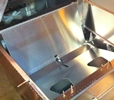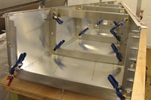


random user submitted photo
Engine Out and the Improbable Turn Back
1 post
• Page 1 of 1
Engine Out and the Improbable Turn Back
So Tuesday night was an extensive EAA Webinar about turning back after engine failure - as well as a demonstration of an APP that would give you an altitude at which you could attempt it - taking account of aircraft type, prevailing wind and surrounding terrain as well as a solution as to where to physically try for. The problem being that now they need a large data set of performance information from different aircraft to program the tool with.
If you missed it - you can view the webinar here:
https://eaa.org/Videos/Webinars/Loss-of ... 3816644001
So yesterday I duly went out and flew a series of turn backs (at a safe altitude) to the parameters requested to help contribute. Now I did this a lot during transition training and the CFI and I discovered that when "on my game" and at maximum gross - I could get my AeroVee Sonex turned around with only 200ft altitude lost. In the end (with a functioning engine) we tried it from as low as 400ft and made a successful return to the airport. (There is a LOT goes into this so don't try it till you are trained and proficient). Now allowing for "klutz" / "heat of the real moment" / "lack of recent proficiency" - I was getting numbers closer to 400ft yesterday and given that I add a cushion to that number - my 800ft minimum remains the number I use at take off.
An interesting data point was the difference in climb ability of two apparently identical Piper aircraft with the same engines and how they performed. The aircraft with the newly overhauled engine easily getting back compared to the aircraft with the almost run to TBO engine. (This is a function of how well they initially Vy climb to altitude and how close they remain to the airport).
Another interesting data set showed that landing straight ahead tended to be more survivable - even into hostile terrain/urban density than turning around. Where pilots killed themselves in a stall. Though it is not clear if they stalled during the turn or if they stalled while trying to execute a downwind landing (which with some training could probably be made much more survivable).
Right at the end of the webinar - retired astronaut Charlie Precourt suggested that a Split S maneuver was probably the fastest way back to the airport with minimum altitude lost. So at a safe altitude - I tired it to see. Dang he was right. Where my 45 degree steep turns at Vg were costing me about 300ft on average (200ft when I nailed it and 400ft when I klutzed it) to get turned around - A Split S entered at Vg got me flipped over and pointed back where I came from for just 175ft - before I worked on refining it. Now here is the question - would I dare try it in the heat of the moment and for real at 500ft if the engine quit??????? :-) And the real answer is probably not at all - because entered at the wrong speed low - the plane mushes downhill in the Split S and loses 600ft. Entered too fast - the radius of the turn is too big because of speed and too much altitude is lost - again about 600ft.
--
If you want to take part in the study to contribute to the data set you can download the free test cards here:
https://eaa.org/eaa/news-and-publicatio ... test-cards
If you missed it - you can view the webinar here:
https://eaa.org/Videos/Webinars/Loss-of ... 3816644001
So yesterday I duly went out and flew a series of turn backs (at a safe altitude) to the parameters requested to help contribute. Now I did this a lot during transition training and the CFI and I discovered that when "on my game" and at maximum gross - I could get my AeroVee Sonex turned around with only 200ft altitude lost. In the end (with a functioning engine) we tried it from as low as 400ft and made a successful return to the airport. (There is a LOT goes into this so don't try it till you are trained and proficient). Now allowing for "klutz" / "heat of the real moment" / "lack of recent proficiency" - I was getting numbers closer to 400ft yesterday and given that I add a cushion to that number - my 800ft minimum remains the number I use at take off.
An interesting data point was the difference in climb ability of two apparently identical Piper aircraft with the same engines and how they performed. The aircraft with the newly overhauled engine easily getting back compared to the aircraft with the almost run to TBO engine. (This is a function of how well they initially Vy climb to altitude and how close they remain to the airport).
Another interesting data set showed that landing straight ahead tended to be more survivable - even into hostile terrain/urban density than turning around. Where pilots killed themselves in a stall. Though it is not clear if they stalled during the turn or if they stalled while trying to execute a downwind landing (which with some training could probably be made much more survivable).
Right at the end of the webinar - retired astronaut Charlie Precourt suggested that a Split S maneuver was probably the fastest way back to the airport with minimum altitude lost. So at a safe altitude - I tired it to see. Dang he was right. Where my 45 degree steep turns at Vg were costing me about 300ft on average (200ft when I nailed it and 400ft when I klutzed it) to get turned around - A Split S entered at Vg got me flipped over and pointed back where I came from for just 175ft - before I worked on refining it. Now here is the question - would I dare try it in the heat of the moment and for real at 500ft if the engine quit??????? :-) And the real answer is probably not at all - because entered at the wrong speed low - the plane mushes downhill in the Split S and loses 600ft. Entered too fast - the radius of the turn is too big because of speed and too much altitude is lost - again about 600ft.
--
If you want to take part in the study to contribute to the data set you can download the free test cards here:
https://eaa.org/eaa/news-and-publicatio ... test-cards
Graeme JW Smith
-

GraemeSmith - Posts: 939
- Joined: Sat May 18, 2019 8:58 am
- Location: RI
1 post
• Page 1 of 1
Who is online
Users browsing this forum: No registered users and 7 guests







